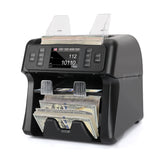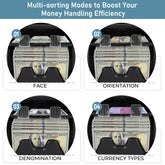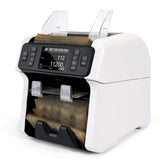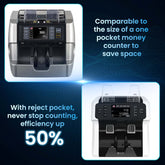How Businesses Can Identify Authentic and Counterfeit Currency
In today's global economy, the U.S. dollar remains one of the most widely used and trusted currencies. However, this widespread use also makes it a prime target for counterfeiters. It's crucial for businesses, travelers, and everyday consumers to be able to distinguish between genuine and counterfeit dollars to protect themselves from fraud. This comprehensive guide is designed to empower you with the knowledge and techniques needed to identify authentic U.S. currency.
We've broken down our guide into three key sections, each focusing on a different aspect of currency verification:
-
Identifying Genuine U.S. Dollars by Touch
-
Identifying Genuine U.S. Dollars Visually
-
Identifying Security Features in U.S. Currency
-
Using Machines to Differentiate Between Genuine and Counterfeit U.S. Dollars.
Identifying Genuine U.S. Dollars by Touch
Touch is one of the most direct and intuitive ways to distinguish between genuine and counterfeit U.S. dollars. By closely examining the feel of the paper, you can uncover subtle yet telling signs of authenticity.
-
Feeling the Paper Texture
Genuine and counterfeit U.S. dollars differ in their paper quality. Authentic bills are crafted from a unique blend of cotton and linen fibers, unlike standard wood pulp paper. This composition makes genuine bills more durable and crisp to the touch, even after years of circulation, while regular paper becomes softer over time. The paper and ink used in real currency are a closely guarded secret, making it challenging for counterfeiters to replicate. Even if you're inexperienced in spotting fakes, the distinct texture difference is noticeable. Authentic bills feature intaglio printing, which you can feel by running your fingernail over the portrait. This creates a tangible ridge, a feature difficult for counterfeiters to mimic.
-
Checking the Thickness of the Bill
Real U.S. currency is typically thinner than its counterfeit counterparts. During the minting process, the paper undergoes thousands of pounds of pressure, resulting in a thinner and crisper note. Counterfeiters often resort to thicker bond paper, easily sourced from office supply stores, as it's their only viable option.
-
Comparing Denominations and Serial Numbers
Each denomination of U.S. currency has unique characteristics. If uncertain about a bill's authenticity, compare it with one you know is genuine. Besides the one and two-dollar bills, all denominations have been redesigned at least once since 1990. The best practice is to compare a suspicious bill with another of the same series and era. While the design of bills might change over the years, the texture remains consistent. A bill made 50 years ago should feel similar to a brand new one.
Important Note: In the event that a business detects a counterfeit bill, the first and foremost action should be to contact local law enforcement immediately. For detailed instructions on how to proceed, including handling and reporting guidelines, refer to our article: What To Do If Merchants Receive Counterfeit U.S. Dollars. This guide offers essential steps for merchants to navigate these incidents while adhering to legal standards and safety practices.
Identifying Genuine U.S. Dollars Visually
Now that we've explored the tactile methods of distinguishing real bills, let's delve into how visual inspection plays a crucial role in identifying genuine U.S. currency.
-
Examining Print Quality
Counterfeit bills often lack the detailed intricacy of genuine currency. The highly secretive and complex printing process of real dollars makes them hard to replicate. Authentic dollars use a unique combination of lithographic and digital printing, not easily duplicated by common counterfeiting tools. Look for the colored fibers in the paper – genuine bills contain small red and blue fibers embedded within, not just printed on the surface like many fakes.
-
Inspecting the Edges
According to the United States Secret Service, “The edges of genuine bills are clear and continuous.” The serrated edges should be crisp and detailed on real bills, whereas counterfeits often exhibit ink smears or irregularities.
-
Observing the Portraits
Minute differences in the portraits can be key indicators of authenticity. On counterfeit bills, portraits may appear clumsy, blurred, and flat, while genuine bills feature sharp, distinct, and detailed images. The portraits on real bills seem to stand out against the background, offering a sense of depth, unlike the blended portraits on counterfeits. Using a magnifying glass, examine the border of the portrait, where you'll find "THE UNITED STATES OF AMERICA" in microprint, appearing as a solid line to the naked eye. This detail is incredibly challenging to replicate with standard office copiers or printers.
-
Checking Serial Numbers
Authentic U.S. dollars feature serial numbers on both sides of the portrait. Ensure these numbers match and that their color corresponds with the Treasury Seal. Counterfeits may have inaccurately positioned or inconsistently spaced serial numbers. If you receive a stack of suspicious bills, check if they all share the same serial number, a common oversight among forgers.
Identifying Security Features in U.S. Currency
After understanding the visual aspects, it's important to recognize the role of technology in the fight against counterfeit currency.
-
Viewing the Security Thread under Normal Light
Hold the bill up to a light source. Except for the one and two-dollar bills, all denominations have a security thread running from top to bottom. This thread is embedded, not printed, and is visible under light. The thread's position varies with different denominations to prevent lower-value bills from being altered to higher denominations. Check both sides for consistency.
-
Examining the Security Thread under UV Light
Under ultraviolet light, the security thread in higher denominations glows in specific colors: $5 in blue, $10 in orange, $20 in green, $50 in yellow, and $100 in pink. If it remains white under UV light, it's likely a counterfeit.
-
Checking for Watermarks
In natural light, look for watermarks on bills issued in 1996 or later for $10, $20, $50, and $100 denominations, and 1999 or later for $5 bills. The watermark, located on the right side of the portrait, is embedded within the paper and visible from both sides.
-
Inspecting Microprinting
Look for microprinted text and numbers that are difficult to discern with the naked eye. Since 1990, bills of $5 and higher denominations have included tiny, intricate details that are often overlooked or blurred by counterfeiters.
Using Machines to Differentiate Between Genuine and Counterfeit U.S. Dollars
In today's fast-paced business environment, relying solely on physical inspection to determine the authenticity of U.S. currency can be impractical, especially for businesses that handle large volumes of cash. Fortunately, technological advancements have led to the development of various devices that streamline the process of detecting counterfeit bills. Here's an overview of some common machines and tools used for this purpose:
-
Currency Counters with Counterfeit Detection
Advanced currency counting machines are equipped with sophisticated features that not only count bills but also check for authenticity. These machines use a combination of ultraviolet (UV), magnetic (MG), infrared (IR), and dimensional validation to scrutinize each bill that passes through them. If a counterfeit bill is detected, the machine will usually pause and alert the user. These devices are ideal for banks, retail stores, and other businesses with high cash throughput.
-
Counterfeit Detection Pens
A more affordable option for small businesses is the counterfeit detection pen. These pens contain a solution that reacts with the starch found in standard paper but not with the cotton-linen blend of genuine U.S. currency. When marked on a counterfeit bill, the ink will change color, indicating a potential fake. While these counterfeit detector pens are simple and cost-effective, they are not foolproof, as they can give false positives or negatives under certain conditions. To further understand the limitations and considerations when using these pens, we encourage readers to explore this detailed article: Why Counterfeit Pens Are Not Reliable.
-
UV Money Detectors
UV money detectors are a budget-friendly solution for verifying the authenticity of currency. These devices emit ultraviolet light, which illuminates the security thread embedded in genuine U.S. bills. Each denomination has a thread that glows a specific color under UV light – a feature difficult for counterfeiters to replicate. These detectors are compact and easy to use, making them suitable for small businesses and retail outlets.
The choice of counterfeit detection method depends on the specific needs and budget of a business. High-volume cash handlers might benefit from investing in advanced currency counting machines with multiple detection technologies. On the other hand, small businesses or those with lower cash volumes may find UV money detectors or counterfeit detection pens sufficient for their needs.
In conclusion, while no method is infallible, combining these tools with manual inspection can significantly reduce the risk of accepting counterfeit currency. By understanding and utilizing these technologies, businesses can protect themselves against the financial losses associated with counterfeit bills.








